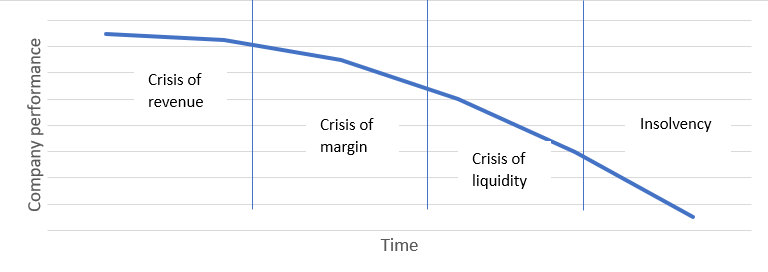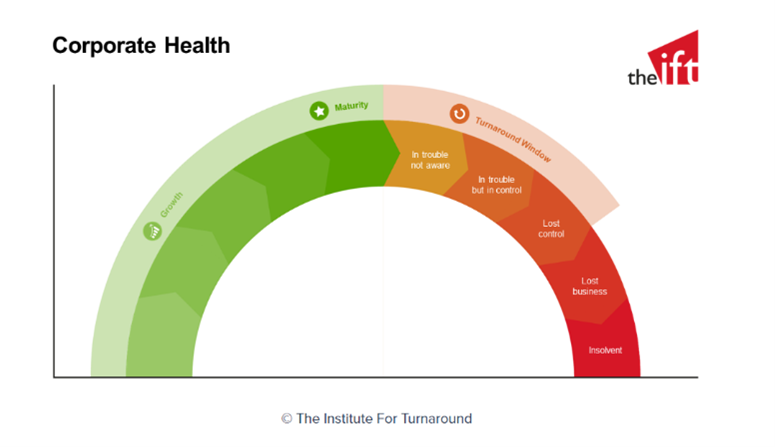From Business Turnaround to a Long-term Future
When I talk to people about what we do as a business, our company turnaround activities tend to spark the most questions and comments. These range from, “Surely business failure is always the fault of bad or fraudulent activities by the owners or directors!” to “so, you cut costs and find ways to borrow more!”
Whilst it may be, in rare circumstances, that a company has failed due to bad practice or fraud, most businesses are just like people, they have a life expectancy, which is largely based around whether people still want to buy what they sell, at a price that they can make money. Currently the average age of a UK company is only 8.6 years with 51% of all companies being less than 10 years old. More than 22,000 registered companies were registered insolvent in 2022, and this excludes the companies that ceased to trade, restructured, or were sold.
For a business to survive for any period of time they have to look after themselves by keeping fit and staying relevant. Many will manage to do this without facing a crisis that risks the entire future of the company, but for some, the company will require a real focus on turning around performance. We see companies facing 3 types of crisis.

For many companies one stage may lead to the next, for example a shortage of revenue may lead to the need to reduce prices, ultimately leading to cash flow difficulties. But others may experience other challenges, for example the current rises in interest rates may cause some companies to experience liquidity issues as a result of increased interest charges without any change in revenues or margin.
If your company is experiencing challenges, the good news is that there is plenty of support out there to help your turnround, restructure, or, if there really are no other options, close the business.
This article is focused on company turnaround, in other words returning the business to health in terms of growth, profitability and liquidity. This may include restructuring and, in some cases, some insolvency practices, but the focus is very much on building the business for the future.
A successful turnaround requires an effective strategy or plan, and considerable resilience and perseverance to transform the crisis into a flourishing business of the future. If your business is facing a crisis there are some key steps:
Carry out an assessment/review of the business
It is essential to carry out a thorough and, most importantly, honest assessment of the business. This should include all elements of the business including market trends, customers, customer satisfaction, products, operations and cost base, financial reports, etc. The aim is to identify the root causes of the current position as well as providing indicators of opportunities for the future.
Develop a turnaround plan
This is step towards recovery and should be clearly based upon the assessment/review. The initial focus should be on the product or service offering and how these will meet customer’s needs. Putting the customer first allows the other elements of the turnaround including, pricing strategies, product and service diversification, sales & marketing, cost reduction and operational efficiencies, and financial plan including structure and divestments, to be aligned on building the business for the future as opposed to a short-term cost cutting exercise. Short-term cost cutting is a valid tool for creating “time” to turn the business round but is unlikely to lead to a long-term resilience in the fundamental performance of the business. The plan needs to be realistic and achievable providing a clear path to the future. In cases where business solvency is a concern the directors must ensure that any planned actions properly take account of, and protect, all stakeholders and creditors appropriately.
Take your employees with you!
This is a key, and often overlooked part of any turnaround plan. In most cases the employees will be well aware of the company’s difficulties with many being concerned about their roles and livelihoods. It is therefore likely that moral will be low even before any conversations on restructuring and efficiencies. A clear plan to engage with the workforce to gain support and trust in the future, and more importantly motivating them to contribute to the future success of the business will be a crucial element of the turnaround plan.
Cash is reality!
If the company does not already do it, now is the time to develop an 8-10 week cash flow forecast and that the working capital cycle is really well managed. Overdue debtors chased, not just sent reminder emails, and excess levels of inventory are sold and reduced. This will allow directors to ensure that they are able to meet their obligations and pay creditors as they fall due. If the forecast indicates that this may not be the case other actions such a further debt restructuring may be necessary.
Remember to get appropriate expert help.
Turning around an underperforming business is a challenging task requiring a wide range of skills. Accredited members of organisations such as the Institute for Turnround are experienced turnaround specialists. They bring an experience of turning around underperforming businesses where the company is:
- Stressed not fatal – These firms lie on the spectrum from under performance through to distress.
- At risk – Failure to reverse business decline will lead to failure.
- A viable future – If it can overcome its immediate troubles, the existing offering or potential offering means that the business has a good chance of succeeding in the medium to long term.
Turnaround will not be a valid solution for all businesses licenced insolvency practitioners and lawyers are available to help company directors where the turnaround window has closed, and the only option is some form of insolvency procedure.

In conclusion, all businesses will at some point experience trading difficulties, some of which may/will threaten their existence, but there are opportunities to turnaround such company’s returning them to growth and profitability. Acting early, with a clear plan, increases the chances of success.
About the author
Mark is the managing director of Where Now Consulting and an accredited member of the Institute for Turnaround. Mark has led successful turnarounds across a wide range of businesses from manufacturing to retail, both within the UK and Europe. His clients have included listed companies, private equity and venture capital backed companies and owner managed SMEs.
For more information, or for a confidential discussion contact:
Mobile: +44 (0) 7887 623999
Email: mspragg@wherenowconsulting.com
Website: www.wherenowconsulting.com
Linkedin: Mark Spragg
About the IFT
The Institute for Turnaround (The IFT) is the UK’s leading membership organisation for turnaround experts. We bring together independent professionals, bankers, investors, and advisers to evolve the profession and respond to new challenges and trends. We are an incubator for turnaround talent, connecting, nurturing, and developing a community of experts at all stages of their career.
For more information contact:
Tel: +44 (0) 20 79479515
Email: info@the-ift.com
Website: www.the-ift.com
